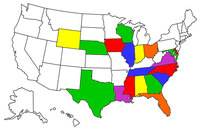This ^^
This particular accident hits home for me, which is why I'm writing this instead of a postition article for NAFI Mentor Magazine. Part of it is because I fly in and out of Indianapolis fairly often (my wife's sister and her husband live about five minutes from Indy Metro). Part of it is because this accident occured in what I consider my "home turf" - I got my private certificate (not "license", although that's an argument for a different thread) at Waukegan Regional what seems like a million years ago and because I also work full time for the railroad that goes through that area.
But more than that. Way back in May of 2000, my wife and I flew from St. Louis back to Waukegan to see family in the northern Chicago suburbs. There were two fronts, as I recall, that were joined together south of St. Louis and were formed a giant "V" that straddled our planned route of flight, with a separation of about 150 - 200 miles on either side of Chicago. I think they were both cold fronts, or the leading one was a cold front and the trailer was a warm front - the latter makes more sense to me, given the conditions.
At Spirit of St. Louis, the bases were about 1,000, with reported tops of about 8,000. We filed for 9,000 and launched. At 9,000 feet were were literally right on top of a stratus layer. Looknig up, I could see stars - out to the left and right, I could see the reflection of our nav lights. It was like this most of the way to Chicago, although around Peoria, the tops did go down a little.
As we were being handed off from Kansas City Center to Peoria Approach, I heard ATC say to a TWA flight "There's a VFR Bellanca stuck on top and he sounds scared - do you have time to help him?" I thought briefly about offering, but I wasn't a CFI at the time and the TWA flight was probably in a better position, crew-wise, to provide assistance. I also did not want to clutter the frequency needlessly. So, off to check in with Peoria.
When we returned from St. Louis and were attending Missouri Pilot's Association picnic the following week, my instructor took me aside and asked me if I heard about the Bellanca that crashed over the weekend. With a sinking feeling, I told him no. It turns out that the non-instrument rated pilot and his passenger were killed in conditions that any instrument pilot wouldn't have tried at an airport without approaches - it would have been a challenge to land at the nearest airport with a precision approach.
The reason that this grieves me is not that I could have saved the day by jumping on the radio - far from it. At the time, I would have had no business trying to do so, and I probably would have made matters worse. No, it's because the narrative seems depressingly familiar. There seems to be an ethos in this business where some people will push to do impossible things, given the limitations of themselves and/or their airplanes. I will say that even the most capable of transport category aircraft, be it Boeing, Airbus, Brazilia, whatever, can be brought down by bad judgement.
Where am I going with this? I've said it elsewhere, and I'll say it here: I have far more respect for a pilot that has the courage to say "Nope, this ain't for me" then I do for the "pilot" that says "Whew - wasn't sure we were gonna make that one!" And it's not the number of hours. It is the quality of training, and, more importantly, the quality of thinking that goes into any flight, whether it's spinning around the patch or going on a transcontinental trip.
As Wes said, there is no compelling reason to ever take off. Even if it means getting fired from your job because you're late. Those of you that are AOPA members can find an article I wrote in Flight Training where I tell the story of getting stuck for week at my in-laws because I simply refused to risk a flight I felt a simple 172 couldn't handle. No, I didn't get fired - in fact, a lot of people in my office were impressed that I had the moxie to say "Oh, well." To add to that, one thing I ask all of my students when it comes to marginal weather (which might be different for VFR and IFR training): "Show me the emergency take off procedure for that airplane."
We, in GA, whether in the experimental faction or in the "spam can" world, must adopt the attitude the real pros, the airlines and business aviation communtiy, have and simply not fly beyond our capabilities. And the equipment and the airplane cannot replace judgement or skill - they are merely tools for our use, that's all.
We also have to adopt a culture where it's OK to listen to our peers when they say "Are you sure about this?" Rod Machado, in his collection Plane Talk has an article entitled "Time to Speak Up" that touches on this. Even if we don't like what we hear, we have to take it into consideration. And the person that cares enough to say something shouldn't be treated as a meddler; instead they should be thanked for caring enough to say something, even if we disagree.
OK, that was a bit disjointed, but I think you get the gist. Fly safely and encourage safe behavior, please, and have a wonderful New Year.




 Reply With Quote
Reply With Quote






